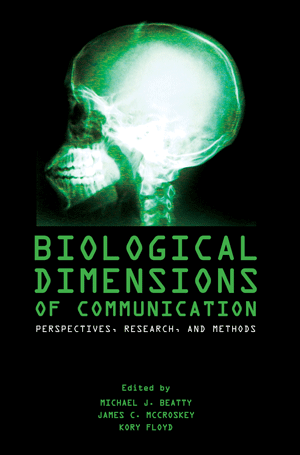Biological Dimensions of Communication: Perspectives, Methods, and Research (Michael J. Beatty, Jame | |
|  | Quantity in Basket:none
Code: 1-57273-874-X
Price:$75.00
Title: Biological Dimensions of Communication
Sub-title: Perspectives, Models and Research
Editor(s): Michael J. Beatty, James C. McCroskey, and Kory Floyd
Publish Date: July 2009
Pages: 314
Format: Cloth
| |
| Over a decade ago, Beatty and McCroskey developed a paradigm for the scientific study of communication that attributed individual differences in communication to individual differences in underlying neurobiological systems. They called this perspective the communibiological paradigm. In addition to proposing a paradigm supported by a rather specific set of assumptions, Beatty and McCroskey sought to provide a platform for the study of the biololgical influences on a wide range of communication processes regardless of paradigmatic orientation.
This edited volume advances that goal. In-depth discussions of theoretical perspectives in addition to communibiology such as evolutionary psychology, cognitive neuroscience and the biosocial approach and methods of biologically based inquiry—including MRI techniques, EEG analysis, and the measurement of heart rate and hormonal response—are contained in the inlcuded chapters. Furthermore, the reader will find coverage of ongoing research programs in interpersonal and mass communication contexts.
Contents: Introduction, Michael J. Beatty. PERSPECTIVES ON BIOLOGY AND COMMUNICATION. Communibiological Paradigm, Michael J. Beatty, James C. McCroskey, and Michelle E. Pence. Communication and Biology: The View From Evolutionary Psychology and Psychophysiology, Kory Floyd and Tim Cole. Cognitive Neuroscience Perspective, Michael J. Beatty and Robert J. Lewis. METHODOLOGICAL APPROACHES. The Neurophysiological Perspective in Mass Communication Research: Theoretical Rationale, Methods and Applications, RenÈ Weber, John Sherry, and Klaus Mathiak. An Introduction to EEG and its Application in Communication Research, Alan D. Heisel. Principles of Endocrine System Measurement in Communication Research, Kory Floyd and James B. Roberts. Electromyographic Response as a Measure of Effortful Cognitive Processing, Derek R. Lane and Nancy Grant Harrington. THEORY AND RESEARCH PROGRAMS. Motivated Mediated Message Processing: How Media Elicit Motivation that Influences How Media Are Processes, Annie Lang and Narine S. Yegiyan. Biology in Theoretical Context: A Parallel Process Model of Nonverbal Communication, Miles L. Patterson. Developmental Factors in the Biosocial Approach, Mark Hickson, III, and Don Stacks. Psychophysiological Patterns of Arousal in Communication, Chris R. Sawyer and Ralph R. Behnke. Cortical Activity and Message Planning, Alan D. Heisel and Michael J. Beatty. Individualistic and Cooperative Affect Systems as Determinants of Aggressive or Collaborative Message Choice, Mark A. Hamilton, Ross W. Buck, Rebecca M. Chory, Michael J. Beatty, and Linda A. Patrylak. Hug Me, Heal Me: Affectionate Communication and Health, Kory Floyd, Colin Hesse, and Perry M. Pauley. Epilogue: A “New” Frontier for Communication Studies, Mark L. Knapp. Author Index. Subject Index. |
| |







